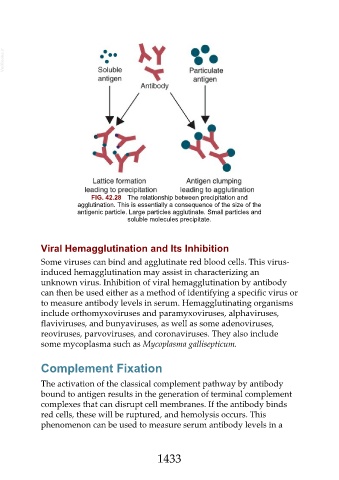Page 1433 - Veterinary Immunology, 10th Edition
P. 1433
VetBooks.ir
FIG. 42.28 The relationship between precipitation and
agglutination. This is essentially a consequence of the size of the
antigenic particle. Large particles agglutinate. Small particles and
soluble molecules precipitate.
Viral Hemagglutination and Its Inhibition
Some viruses can bind and agglutinate red blood cells. This virus-
induced hemagglutination may assist in characterizing an
unknown virus. Inhibition of viral hemagglutination by antibody
can then be used either as a method of identifying a specific virus or
to measure antibody levels in serum. Hemagglutinating organisms
include orthomyxoviruses and paramyxoviruses, alphaviruses,
flaviviruses, and bunyaviruses, as well as some adenoviruses,
reoviruses, parvoviruses, and coronaviruses. They also include
some mycoplasma such as Mycoplasma gallisepticum.
Complement Fixation
The activation of the classical complement pathway by antibody
bound to antigen results in the generation of terminal complement
complexes that can disrupt cell membranes. If the antibody binds
red cells, these will be ruptured, and hemolysis occurs. This
phenomenon can be used to measure serum antibody levels in a
1433

